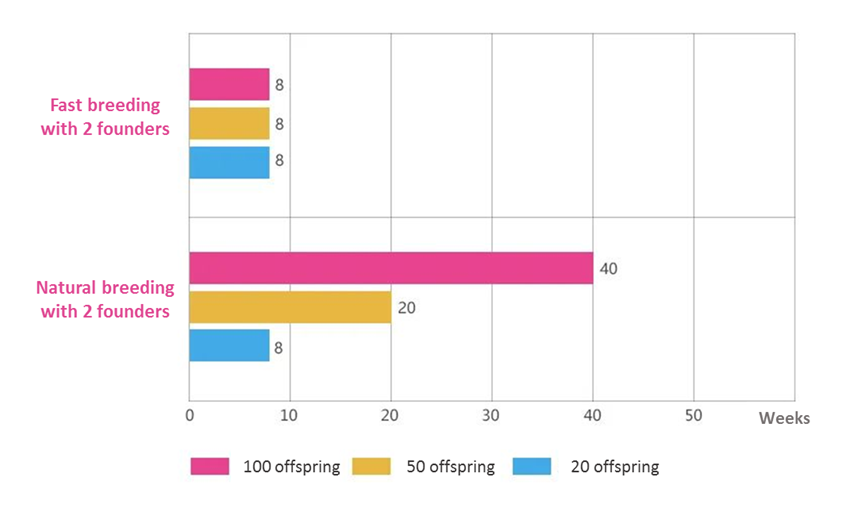
Many researchers that use rat models for their studies face issues when it comes to breeding. This can be due to a number of reasons, a few of which we offer below:
Cyagen’s animal model experts have developed Fast Breeding services, which can help resolve all of the above problems faced by the researchers.
Herein, learn how we can reduce natural rat reproduction from 40 weeks to as few as 8 weeks with our fast-breeding techniques.
Learn about Fast Breeding
Cyagen performs fast breeding of rodents, including rats, using a combination of the below methods:
Fast breeding= superovulation + in vitro fertilization (IVF) + embryo transfer
Fast breeding can help researchers get more positive rodents in a shorter period, so as to rapidly expand the breeding scale according to their needs.
In vitro fertilization (IVF), as the core technology of fast breeding, can efficiently produce fertilized eggs. In vitro fertilization in mice has been practically applied in many experimental and breeding facilities around the world, but IVF in rats is fraught with difficulties. Compared with other species, the reproducibility of IVF in rats is low and cannot be widely used in the breeding of rats. Many facilities still obtain embryos through natural mating.
Comparison of In Vitro Fertilization in Mice and Rats
|
|
In Vitro Fertilization (IVF) in Mice |
In Vitro Fertilization (IVF) in Rats |
|
Sperm Survival Time |
Longer survival time of sperm |
Shorter survival time of sperm |
|
Embryonic Development |
Embryos can develop to blastocysts (64~128-cell) |
Embryos often cease development at the 2-cell stage, a phenomenon known as the 2-cell block |
|
Cell Death Rate |
Low cell death rate |
Prone to deformities; 2-cells are prone to death the next day |
|
Body Size |
Smaller body size, easier to handle |
Larger body size; handling 12 superovulated female rats is equivalent to handling 30 mice |
|
Reagent Price |
Lower reagent prices |
Higher reagent prices |
Advantages of Fast Breeding of Rats
Fast breeding by IVF is equivalent to the simultaneous mating of a male rat and a large number of female rats, which ensures the consistency of the birth age of the rats and reduces the experimental errors caused by the difference in the age of the rats. The cohort age consistency improves the reliability of experimental data, thus making the experimental results more reproducible.
Fast breeding can help save months (32 weeks) of natural breeding time. Compared with normal females, superovulatory females have a significantly shorter time to sexual maturity and can start mating more quickly.
Over 100 rats of the same age can be obtained in a short time, perfect for quickly developing cohort groups.
For males that are difficult to breed naturally, IVF is a good way to obtain animals with a higher level of health.
Are you still struggling with the breeding of rats when you are exhausted from reading literature and doing experiments?
It's better to leave this thorny problem to Cyagen, and quickly get a large number of age-matched rats in just one step! It takes 40 weeks for a rat to naturally breed 100 offspring, but we can help you fast forward to as few as 8 weeks! Cyagen’s Fast Breeding shaves up 32 weeks off the delivery of large rat cohorts, as shown below:

Figure 1. Comparison of the duration of rapid breeding and natural breeding in rats.
Why Choose Cyagen?
Cyagen provides one-stop rat breeding services for your rat models. In addition, we also help you with gene editing services in rats, such as knockout, point mutation, knock-in, covering SD, Wistar, Long Evans, F344, Brown Norway rats.
For a limited time, order any cKO/cKI rat models to receive a free Cre driver rat strain custom-developed to support your field of study. Place an order by June 30, 2022 to qualify for your free Cre strain!
We will respond to you in 1-2 business days.